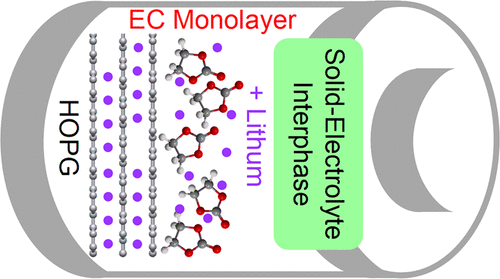Our official English website, www.x-mol.net, welcomes your
feedback! (Note: you will need to create a separate account there.)
Adsorption of Ultrathin Ethylene Carbonate Films on Pristine and Lithiated Graphite and Their Interaction with Li
Langmuir ( IF 3.7 ) Pub Date : 2018-06-26 00:00:00 , DOI: 10.1021/acs.langmuir.8b01054 Maral Bozorgchenani 1 , Florian Buchner 1, 2 , Katrin Forster-Tonigold 2, 3 , Jihyun Kim 1 , Axel Groß 2, 4 , R. Jürgen Behm 1, 2
Langmuir ( IF 3.7 ) Pub Date : 2018-06-26 00:00:00 , DOI: 10.1021/acs.langmuir.8b01054 Maral Bozorgchenani 1 , Florian Buchner 1, 2 , Katrin Forster-Tonigold 2, 3 , Jihyun Kim 1 , Axel Groß 2, 4 , R. Jürgen Behm 1, 2
Affiliation

|
Aiming at a better understanding of the solid–electrolyte interphase formation in Li-ion batteries, we have investigated the interaction of ultrathin films of ethylene carbonate (EC), which is a key solvent of battery electrolytes, with pristine and lithiated highly oriented pyrolytic graphite (HOPG) and with postdeposited Li. Employing X-ray and ultraviolet photoelectron spectroscopy as well as Fourier transform infrared spectroscopy under ultrahigh-vacuum conditions, in combination with density functional theory (DFT)-based calculations, we find that EC adsorbs molecularly intact on pristine HOPG in the entire temperature range between 80 K and desorption at 200 K. Features in the ultraviolet photoelectron spectra could be related to the molecular orbitals of EC obtained from DFT calculations, and a similar adsorption/desorption behavior is obtained also on lithiated HOPG. In contrast, stepwise postdeposition of ∼0.5 and one monolayer of Li0 on a preadsorbed EC adlayer leads not only to stabilization of Li+/Liδ+ at the surface, possibly as adsorbed Li+(EC)n species, but also to EC decomposition, forming products such as Li2CO3, ROCO2Li (CH2OCO2Li)2, and Li2O. Consequences on the electronic surface properties and on the stabilization of the resulting adlayer are discussed. Upon annealing up to room temperature, some residual Li-containing decomposition products remain on the surface, which is considered as the initial stage of the solid|electrolyte interphase formation at the electrode|electrolyte interface.
中文翻译:

超细碳酸亚乙酯薄膜在原始和锂化石墨上的吸附及其与锂的相互作用
为了更好地了解锂离子电池中的固体-电解质界面形成,我们研究了碳酸亚乙酯(EC)的超薄膜与电池的原始和锂化高取向热解石墨之间的相互作用。碳酸亚乙酯是电池电解质的关键溶剂。 (HOPG)并与李某同存。在超高真空条件下,利用X射线和紫外光电子能谱以及傅里叶变换红外光谱,结合基于密度泛函理论(DFT)的计算,我们发现EC在整个温度范围内在分子上完整地吸附在原始HOPG上80 K,200 K解吸。紫外光电子光谱的特征可能与通过DFT计算获得的EC的分子轨道有关,在锂化HOPG上也获得了相似的吸附/解吸行为。相比之下,逐步沉积〜0.5和一层Li0上的预吸附EC吸附层不仅导致锂的稳定+ /锂δ+在表面处,可能作为吸附锂+(EC)ñ物种,而且还EC分解,形成产物如Li 2 CO 3,ROCO 2 Li(CH 2 OCO 2 Li)2和Li 2O.讨论了电子表面性能和所得的添加剂的稳定性的后果。在室温进行退火后,残留的一些含Li的分解产物残留在表面上,这被认为是在电解质界面处形成电解质间相的初始阶段。
更新日期:2018-06-26
中文翻译:

超细碳酸亚乙酯薄膜在原始和锂化石墨上的吸附及其与锂的相互作用
为了更好地了解锂离子电池中的固体-电解质界面形成,我们研究了碳酸亚乙酯(EC)的超薄膜与电池的原始和锂化高取向热解石墨之间的相互作用。碳酸亚乙酯是电池电解质的关键溶剂。 (HOPG)并与李某同存。在超高真空条件下,利用X射线和紫外光电子能谱以及傅里叶变换红外光谱,结合基于密度泛函理论(DFT)的计算,我们发现EC在整个温度范围内在分子上完整地吸附在原始HOPG上80 K,200 K解吸。紫外光电子光谱的特征可能与通过DFT计算获得的EC的分子轨道有关,在锂化HOPG上也获得了相似的吸附/解吸行为。相比之下,逐步沉积〜0.5和一层Li0上的预吸附EC吸附层不仅导致锂的稳定+ /锂δ+在表面处,可能作为吸附锂+(EC)ñ物种,而且还EC分解,形成产物如Li 2 CO 3,ROCO 2 Li(CH 2 OCO 2 Li)2和Li 2O.讨论了电子表面性能和所得的添加剂的稳定性的后果。在室温进行退火后,残留的一些含Li的分解产物残留在表面上,这被认为是在电解质界面处形成电解质间相的初始阶段。











































 京公网安备 11010802027423号
京公网安备 11010802027423号